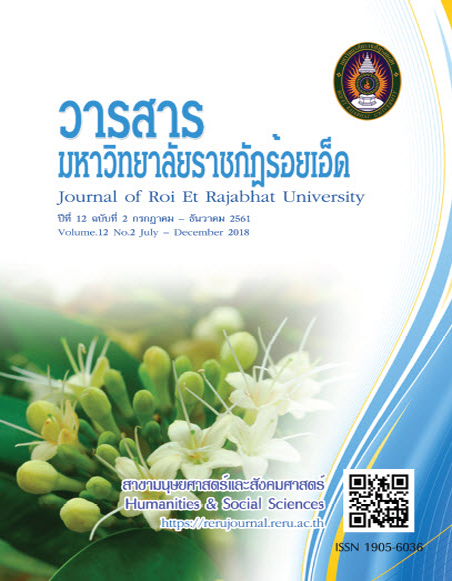The Preservation of Nong Kung Chan Phang Village Cotton Weaving Wisdom. Case Study: Thak Tor Thai Group in Nong Kung Chan Phang village, Nong Rue Sub-District, Nonsang District, Nongbualamphu Province.
Keywords:
Preservation, Local wisdom, Cotton weavingAbstract
The objectives of this study were to 1) study the local wisdom of cotton weaving at Ban Nong Kung Charn Pang. 2) investigate the guidelines of preserving local wisdom of cotton weaving of Ban Nong Kung Charn Pang. Ten participants of this study were from two target groups: the official leaders and the workers in the community. The structured and the unstructured interviews were selected as instruments for gathering the data. The three-dimensional method was used for data analysis. For data presentation, descriptive analysis was shown in this study. The results revealed that the background of cotton weaving at Ban Nong Kung Chan Pang was based on the citizens’ knowledge and experience in weaving. In addition, the citizens in this community started weaving cotton for their family, then they were trained in weaving by “Thak Tor Thai” group. After. that, they transferred their knowledge of weaving to the nearby community. Nowadays, cotton weaving of this community has been developed to be distinguished and unique. As for guidelines to preserve local wisdom of cotton weaving, various transferring knowledge of cotton weaving have been transferred to learners such as statement, learning by doing, and establishment of the cotton weaving profession group in the community. Moreover, the weaving network has been promoted, and the cooperation of knowledgeable people and community leaders has also been promoted in order to promote the supportive networks of community producers and other communities. From the results of this research above, it is said that the preservation of local wisdom of cotton weaving should be promoted by cultivating good moral traits for the local people, especially the youth in the community.
References
ทรงพล ต่วนเทศ. (2555). การศึกษาภูมิปัญญาการทอผ้าพื้นเมืองของคนไทยเชื้อสายลาวครั่งในจังหวัดสุพรรณบุรี ชัยนาท และอุทัยธานี. วิทยานิพนธ์ การศึกษามหาบัณฑิต สาขาวิชาศิลปศึกษา. กรุงเทพฯ: มหาวิทยาลัยศรีนครินทรวิโรฒ.
ทองคำ ภูมิชัยโชติ. บ้านเลขที่ 40 หมู่ที่ 6 บ้านหนองกุงจารย์ผาง ตำบลหนองเรือ อำเภอโนนสัง จังหวัดหนองบัวลำภู. (4 เมษายน 2560). สัมภาษณ์.
ทับทิม พันแน่น. บ้านเลขที่ 139 หมู่ที่ 6 บ้านหนองกุงจารย์ผาง ตำบลหนองเรือ อำเภอโนนสัง จังหวัดหนองบัวลำภู. (4 เมษายน 2560). สัมภาษณ์.
ทัศนา แสวงศักดิ์. (2549). ความสัมพันธ์ระหว่างสถานศึกษากับชุมชนตามแนวปฏิรูปการศึกษา. กรุงเทพฯ: ภาควิชาบริหารการศึกษา คณะศึกษาศาสตร์ มหาวิทยาลัยศรีนครินทรวิโรฒ.
ภัทรวดี อัคลา. (2558). 2 nd National and International Graduate Conference. 25 กันยายน 2558. KU Home.
วัฒนา จูฑะวิภาต. (2555). ผ้าทอกับชีวิตคนไทย. กรุงเทพฯ: มหาวิทยาลัยธุรกิจบัณฑิตย์.
วิภาวี กฤษณะภูติ. (2555). การจัดการกลุ่มวิสาหกิจชุมชน: การเรียนรู้จากกลุ่มอาชีพทอผ้าไหมและทอผ้าฝ้ายในจังหวัดขอนแก่น. วารสารคณะมนุษยศาสตร์และสังคมศาสตร์ มหาวิทยาลัยขอนแก่น, 30(1), 165–188.
ศิริญญา หาญไชยชนะ. (2545). เส้นสายลายไหม. กรุงเทพฯ: กรมวิชาการ กระทรวงศึกษาธิการ.
สกุล เพ็งดวงใหญ่. บ้านเลขที่ 55 หมู่ที่ 6 บ้านหนองกุงจารย์ผาง ตำบลหนองเรือ อำเภอโนนสัง จังหวัดหนองบัวลำภู. (5 เมษายน 2560). สัมภาษณ์.
สมนึก อินเอี่ยม. บ้านเลขที่ 43/6 หมู่ที่ 6 บ้านหนองกุงจารย์ผาง ตำบลหนองเรือ อำเภอโนนสัง จังหวัดหนองบัวลำภู. (4 เมษายน 2560). สัมภาษณ์.
ส่วย จันทร์เติม. บ้านเลขที่ 28 หมู่ 6 บ้านหนองกุงจารย์ผาง ตำบลหนองเรือ อำเภอโนนสัง จังหวัดหนองบัวลำภู. (5 เมษายน 2560). สัมภาษณ์.
สุมิตรา อภิชัย. (2549). ความสำเร็จของกลุ่มวิสาหกิจชุมชนในจังหวัดเชียงใหม่. วิทยานิพนธ์ ศิลปศาสตรมหาบัณฑิต สาขาวิชาบริหารการพัฒนา. เชียงใหม่: มหาวิทยาลัยแม่โจ้.
สารานุกรมไทย สาหรับเยาวชน เล่ม 15. (2543). ผ้าไทย. กรุงเทพฯ: ด่านสุทธาการพิมพ์.
หนูกันต์ ศรีหะ. บ้านเลขที่ 23 หมู่ที่ 6 บ้านหนองกุงจารย์ผาง ตำบลหนองเรือ อำเภอโนนสัง จังหวัดหนองบัวลำภู. (6 เมษายน 2560). สัมภาษณ์.
Brundage, D.H. and D. Mackeracher. (1980). Adult learning Principles and their. Application to program Planning. Toronto : the Ontario Institute for Studies In Education.
Downloads
Published
How to Cite
Issue
Section
License
บทความที่ได้รับการตีพิมพ์เป็นลิขสิทธิ์ของวารสารมหาวิทยาลัยราชภัฎร้อยเอ็ด
ข้อความที่ปรากฏในบทความแต่ละเรื่องในวารสารวิชาการเล่มนี้เป็นความคิดเห็นส่วนตัวของผู้เขียนแต่ละท่านไม่เกี่ยวข้องกับมหาวิทยาลัยราชภัฎร้อยเอ็ด และคณาจารย์ท่านอื่นๆในมหาวิทยาลัยฯ แต่อย่างใด ความรับผิดชอบองค์ประกอบทั้งหมดของบทความแต่ละเรื่องเป็นของผู้เขียนแต่ละท่าน หากมีความผิดพลาดใดๆ ผู้เขียนแต่ละท่านจะรับผิดชอบบทความของตนเองแต่ผู้เดียว





